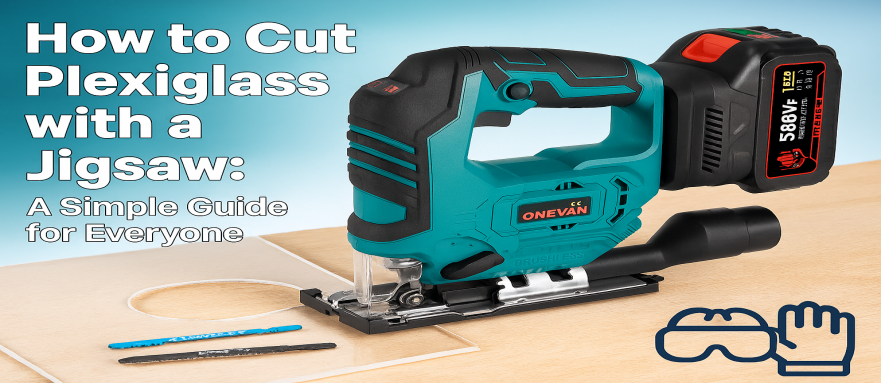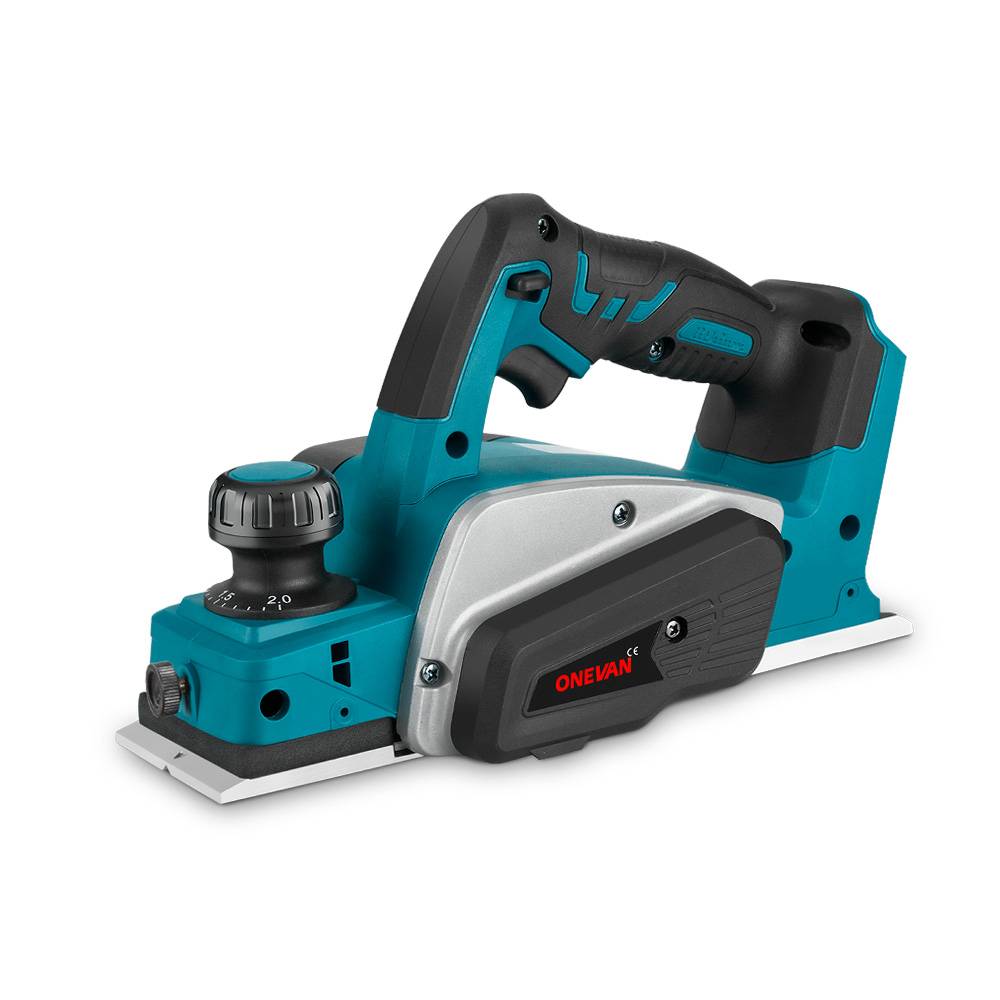Acrylic, commonly referred to as Plexiglas or Perspex, is a clear, strong material that can be used for signs, displays, and home projects. It resembles glass, but it is lighter and more durable. Many people ask, “Can you cut Plexiglass with a jigsaw?” Of course you can! Cutting Plexiglass is not difficult, and a jigsaw like the ONEVAN 135mm Brushless Cordless Jigsaw helps cut precise pieces. This tutorial teaches you the steps on how to cut Plexiglass using a jigsaw. We will discuss tools, safety, blades, and methods in a step-by-step manner.
You will also learn how to cut straight lines, curves, and even circles. We’ll also answer questions like “What jigsaw blade to use for Plexiglass?” and “How to cut thin Plexiglass with a jigsaw?” This article has something to offer, no matter whether you are a complete novice when it comes to DIY or an established professional.
1. Can You Cut Plexiglass with a Jigsaw?
What Is a Jigsaw?
A jigsaw is a hand-operated tool whose blade is up and down. It can cut wood, metals, and plastics such as Plexiglass. A very good example is the ONEVAN 135mm Brushless Cordless Jigsaw. It and use the ONEVAN 18VLithium-Ion battery and also can compatible with Makita 18V batteries and has strokes per minute (SPM) of up to 3,000. It is easy to hold and change blades without the need for additional tools. Jigsaws work well on detailed cuts since they are easy to maneuver.
Why Use a Jigsaw for Plexiglass?
Jigsaws are great for Plexiglass. Here’s why:
-
Versatile Cuts: They make straight lines, curves, and shapes like circles. This is ideal for creative projects.
-
Easy to Use: Anyone can learn to use a jigsaw. The controls are simple.
-
Speed Control: You can adjust the speed to suit your needs. The ONEVAN jigsaw goes from 0 to 3,000 SPM. This helps with different Plexiglass thicknesses.
-
Affordable: Jigsaws cost less than fancy tools like laser cutters. They’re great for small budgets.
-
Precise: With the right blade, jigsaws make clean, accurate cuts.
-
Portable: Cordless jigsaws let you work anywhere. No need for a power outlet.
- Handles Different Thicknesses: Jigsaws can cut Plexiglass sheets up to 20 mm thick; however, thinner sheets (1-6 mm) are generally easier to work with and produce cleaner cuts.
Problems to Watch For While Cutting Plexiglass with a Jigsaw
Cutting Plexiglass with a jigsaw has some challenges:
-
Cracking: you can break plexiglass when pushing it.
-
Heat: A quick-cutting temperature is generated. This has the potential of melting edges.
-
Vibration: Shaking may end up in uneven cuts.
-
Thick Sheets: Jigsaws cannot handle Plexiglass that measures above 20 mm.
-
Melting Edges: A sharp blade can also melt Plexiglass, and a fast-moving one would leave rough edges.
Don’t worry. These problems can be avoided with the proper measures.
2. Preparing to Cut Plexiglass with a Jigsaw
Safety PPE for Cutting Plexiglass with a Jigsaw
Safety is super important. Cutting Plexiglass creates dust and sharp edges. Follow these tips:
- Goggles: Wear goggles to protect your eyes from pieces of Plexiglass.
- Wear Gloves: Protect your hands from cuts caused by sharp edges.
- Use a Mask:Avoid inhaling acrylic dust.
- Open Air Work: Perform cutting operations in a well-ventilated area to prevent the accumulation of dust and fumes, which can be harmful if inhaled. The dust port of the ONEVAN jigsaw helps minimize dust accumulation, improving visibility and safety during cutting.
- Tie-back clothes: Ensure that sleeves and jewelry are tied back to prevent them from getting caught in the tool.
Get Your Tools Ready Before Cutting Plexiglass with a Jigsaw
You’ll need these items:
-
Jigsaw: A model like the ONEVAN 135mm Brushless Cordless Jigsaw works well.
-
Blades: Select blades specifically designed for Plexiglass (more on this later).
-
Clamps: Hold the Plexiglass steady.
-
Measuring Tape and Marker: Mark your cut lines clearly.
-
Straightedge: Helps with straight cuts.
-
Masking Tape: Stops chipping along cut lines.
-
Sandpaper or Torch: Smooth edges after cutting.
- Backing Board: Provides support for Plexiglass sheets, helping to prevent shaking and vibrations during cutting, especially for thinner materials.
Plexiglass is manufactured as sheets with a thickness of 1 mm to 20 mm. Jigsaws are best used with thin sheets (1-6 mm). The thicker will require slower speeds and special blades. Choose the appropriate thickness for your task.
3. Types of Jigsaw Blades for Plexiglass
The blade you choose matters a lot. Here’s what works for Plexiglass:
-
Acrylic Blades: Specifically designed for cutting Plexiglass, these blades typically feature fine teeth that help minimize chipping.
-
High TPI Blades (10–20 TPI): These blades have 10–20 teeth per inch, making them ideal for cutting thin sheets of Plexiglass smoothly. For thicker materials, consider using lower TPI blades for a more aggressive cut.
-
Bi-Metal Blades: Strong and flexible. Good for Plexiglass and other materials.
-
Fine Tooth Wood Blades: Suitable for Plexiglass but may chip slightly.
-
Scroll Blades: Thin and narrow. Great for curves and circles.
-
Thin Kerf Blades: Cut with less waste and heat. Best for thin Plexiglass.
For most jobs, a 10–20 TPI acrylic blade is the best jigsaw blade to cut Plexiglass. Check the blade’s label for “acrylic” or “plastic” to be sure.
4. How to Cut Plexiglass with a Jigsaw Step-by-Step Guide
To achieve good results, follow these steps.
Step 1: Measure and Mark
Use a tape measure to measure the size of your Plexiglass. Draw the cut line with a marker. For straight cuts, use a straightedge. For circles, use a compass or round object. Check your marks twice. Put masking tape over the cut line. This stops chipping. Draw on the tape for extra clarity.
Step 2: Secure the Plexiglass
Place the Plexiglass on a flat table. For thin sheets, add a backing board to stop shaking. Clamp the sheet tightly. Ensure the cut line extends beyond the edge. This keeps your table safe. Tight clamps prevent slipping.
Step 3: Set Up the Jigsaw
Put in a 10–20 TPI or acrylic blade. Set the jigsaw to a low speed (800–1,500 strokes per minute, SPM) to reduce heat buildup. For the ONEVAN jigsaw, turn the speed dial to the lowest setting. Set the pendulum to 0 or 1 for smoother cuts. Check the battery to see if it’s cordless. Make sure the blade is sharp.
Step 4: Cutting Techniques
- Speed and Pressure: Start the jigsaw before touching the Plexiglass. Use light, steady pressure. Let the blade cut naturally. Pushing too hard can cause the Plexiglass to crack.
-
Straight Cuts: Line up the jigsaw’s base with the cut line. Use a straightedge for accuracy. Move slowly and keep the base flat.
-
Curves and Circles: To cut a circle in Plexiglass with a jigsaw, drill a small hole inside the circle. Use a scroll blade. Follow the line slowly. For curves, use a narrow blade and guide carefully. Practice on scrap first.
- Thin Plexiglass Tips: Thin sheets (1–3 mm) are prone to shaking easily. Use a backing board and clamps. Set the speed low (800–1,200 SPM). Press lightly to avoid bending.
Extra Tips for Clean Cuts
-
Pause if Hot: If the Plexiglass feels warm, stop cutting immediately to allow it to cool and prevent melting, which can result in rough edges.
-
Check the Blade: A dull blade makes rough cuts. Swap it out if it’s not cutting well.
-
Use a Guide: A straightedge keeps lines straight. It’s optional for curves.
- Test First: Try your settings on a scrap piece of material. Adjust speed or blade if needed.
5. Finishing Touches After Cutting Plexiglass with a Jigsaw
Smooth the Edges
Cut edges might be rough. Here’s how to fix them:
-
Sanding: Use 400–600 grit sandpaper. Rub in circles until smooth. Move to 800 grit for a shiny finish.
-
Flame Polishing: Use a small butane torch. Pass it quickly over the edge to melt it slightly. This makes it glossy. Be careful not to burn it.
-
Scraping: Use a metal scraper for small burrs before sanding.
Go slow to keep the Plexiglass looking good. Wear gloves for safety.
Clean Up
After cutting, tidy up:
-
Peel Tape: Remove masking tape gently. Wipe off sticky residue with a wet cloth.
-
Clear Dust: Sweep or vacuum acrylic dust. Use the jigsaw’s dust port during cutting to reduce mess.
-
Recycle Scraps: Plexiglass can be recycled. Check your local rules.
-
Store Tools: Clean the jigsaw. Put blades away safely. Charge the battery if needed.
A clean space helps keep your tools in good condition.
6. Troubleshooting Problems for Cutting Plexiglass with a Jigsaw
Sometimes things go wrong. Here’s how to fix common issues:
-
Cracking: To prevent cracking, apply consistent, light pressure while ensuring the blade is sharp and the sheet is tightly clamped.
-
Melting Edges: Lower the speed. Use a high TPI blade. Stop if the material gets warm.
-
Wobbly Cuts: Vibrations cause this. Use a backing board and tighter clamps.
- Stuck Blade: Stop the jigsaw. Pull the blade out gently. Look for dullness or debris. Replace it if needed.
7. Advanced Cutting Ideas for Cutting Plexiglass with a Jigsaw
Want to try something tricky? Here are some ideas:
-
Intricate Designs: Use a scroll blade for detailed patterns. When cutting intricate designs, take your time and practice on scrap pieces to ensure accuracy.
-
Cutting Curves: Narrow blades make curves easier. Follow the line carefully.
-
Multiple Sheets: Don’t stack Plexiglass. Cut one sheet at a time to avoid cracks.
- Lubrication: You don’t need it. A sharp blade and the right speed work fine.
8. Picking the Right Plexiglass
Not all Plexiglass is the same. Here’s what to know:
-
Cast vs. Extruded: Cast Plexiglass is harder and typically cuts cleaner, while extruded Plexiglass is softer, more flexible, and tends to melt more easily during cutting.
-
Thickness: Thin sheets (1–6 mm) are ideal for use with jigsaws. Thicker ones (10–20 mm) need slow speeds.
- Color: Clear, colored, or frosted Plexiglass cuts the same. Pick what fits your project.
9. Fun Projects with Plexiglass
Plexiglass is great for creative projects. Try these:
-
Signs: Cut letters or shapes for custom signs. Sand edges for a polished look.
-
Shelves: Make clear shelves for a modern vibe. Cut straight lines for clean edges.
-
Picture Frames: Cut Plexiglass for lightweight frames. Use a scroll blade for rounded corners.
- Decorative Panels: Cut circles or curves for wall art. Flame polish for a glossy finish.
10. Keeping Your Jigsaw in Top Shape
Take care of your jigsaw to make it last:
-
Clean It: Clean with dust after the use.
-
Inspection of Check Blades: Change blunt or distorted blades.
-
Battery-Care: Ensure that rechargeable batteries are fully charged before use. Keep them in a cool environment.
-
Check off Parts: Before cutting, check for loose screws or damage.
Good maintenance means better cuts and safer work.
11. Why Choose the ONEVAN Jigsaw?
The ONEVAN 135mm Brushless Cordless Jigsaw stands out. It’s cordless so that you can work anywhere. Its speed control and dust port make it perfect for Plexiglass. Plus, it’s built for comfort, so your hands won’t tire out. It’s a solid choice for any DIYer.
12. Conclusion
Many people think that it is hard to cut Plexiglass using a jigsaw. You can straight cut, curve, or cut circles with a tool such as the ONEVAN 135mm Brushless Cordless Jigsaw. The most effective approach is to select a blade with a 10-20 TPI draft and acrylic. Wear the Plexiglass, operate at low speeds, and apply light pressure to circumvent cracking or melting tendencies. Finish with sandpaper or a torch to achieve a professional finish.
This guide answers questions like “Can I cut Plexiglass with a jigsaw?” and “How to cut a circle in Plexiglass with a jigsaw?” Practice will enable you to easily develop excellent projects.
13. FAQs
What’s the best thickness of Plexiglass to cut with a jigsaw?
There are no issues with sheets up to 6 mm thick. To cut 20 mm, slow blades, and powerful blades allow for efficient cutting.
Can I cut curved shapes in Plexiglass using a jigsaw?
Yes. Take the scroll blade and go slowly. Start on scrap.
Do I need a guide when cutting Plexiglass with a jigsaw?
With straight cuts, a guide is used. Curves may be cut freehand.
What speed should I use on my jigsaw for Plexiglass?
Set the jigsaw speed to between 800 and 1,500 SPM. Slow speeds do not allow melting.
How can I prevent melting Plexiglass when cutting with a jigsaw?
Take low-speed and high TPI blades. Quit when the material becomes hot.
Can I cut multiple layers of Plexiglass at once with a jigsaw?
No. Do not cut all the sheets at once; cut them singly; otherwise, it will crack.
What if my jigsaw blade gets stuck while cutting-triad cutting Plexiglass?
Put a halt to the jigsaw. Withdraw gently the blade. Look to see whether it is dull or has debris. Exchange it as necessary.
Do I need lubrication when cutting Plexiglass with a jigsaw?
No. A keen knife and proper pace suffice.
Can I use a jigsaw to cut Plexiglass with intricate designs?
Yes. To use fine shapes, move a scroll blade. Move slowly.
How do I know when to replace my jigsaw blade while cutting Plexiglass?
When it chips, melts, or cuts slowly, it is dull. Exchange it with a new one.
Tags:
how to cut Plexiglass with a jigsaw, can you cut Plexiglass with a jigsaw, what jigsaw blade to use for Plexiglass, how to cut a circle in Plexiglass with a jigsaw, cutting thin Plexiglass with a jigsaw, best jigsaw blade for Plexiglass, can a jigsaw cut Plexiglass, how to cut Perspex with a jigsaw, jigsaw cutting techniques for Plexiglass, ONEVAN jigsaw for Plexiglass









